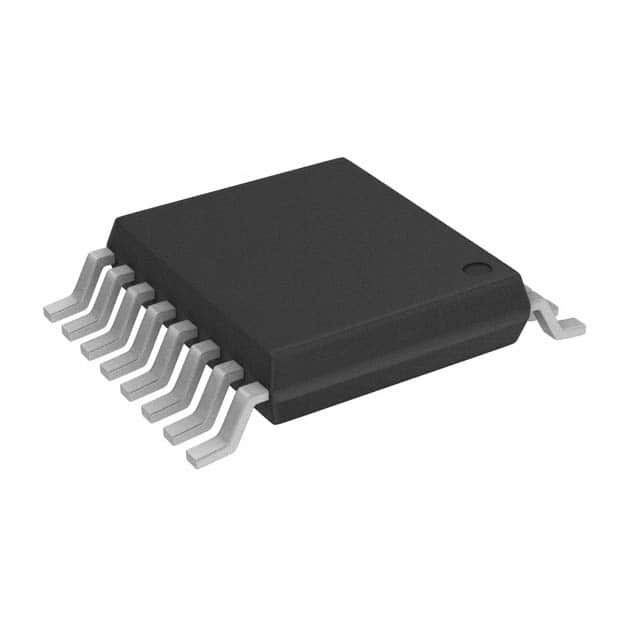Lihat spesifikasi untuk detail produk.

ST232BTR
Product Overview
Category
ST232BTR belongs to the category of integrated circuits (ICs).
Use
The ST232BTR is commonly used for voltage level translation in serial communication systems.
Characteristics
- Voltage level translation between TTL/CMOS logic levels and RS-232 signals
- Supports data rates up to 120 kbps
- Low power consumption
- Wide operating voltage range: 3V to 5.5V
- ESD protection for RS-232 I/O pins
Package
ST232BTR is available in a small outline package (SOIC) with 16 pins.
Essence
The essence of ST232BTR lies in its ability to facilitate communication between devices operating at different voltage levels, ensuring compatibility and reliable data transmission.
Packaging/Quantity
ST232BTR is typically packaged in reels or tubes, with a quantity of 2500 units per reel/tube.
Specifications
- Supply voltage: 3V to 5.5V
- Operating temperature range: -40°C to +85°C
- Data rate: Up to 120 kbps
- Number of channels: 2 (transmitter and receiver)
- Logic voltage levels: TTL/CMOS (0V to Vcc) and RS-232 (-25V to +25V)
Detailed Pin Configuration
- VCC - Power supply voltage
- GND - Ground reference
- T1IN - TTL/CMOS input for transmitter channel 1
- T1OUT - RS-232 output for transmitter channel 1
- R1IN - RS-232 input for receiver channel 1
- R1OUT - TTL/CMOS output for receiver channel 1
- R2OUT - TTL/CMOS output for receiver channel 2
- R2IN - RS-232 input for receiver channel 2
- T2OUT - RS-232 output for transmitter channel 2
- T2IN - TTL/CMOS input for transmitter channel 2
- C1+ - Capacitor connection for charge pump 1
- C1- - Capacitor connection for charge pump 1
- C2- - Capacitor connection for charge pump 2
- C2+ - Capacitor connection for charge pump 2
- SHDN - Shutdown control input (active low)
- VCC - Power supply voltage
Functional Features
- Bidirectional voltage level translation between TTL/CMOS and RS-232 signals
- Automatic power shutdown mode when not in use (SHDN pin)
- Integrated charge pumps for generating RS-232 voltage levels
- ESD protection for RS-232 I/O pins
Advantages and Disadvantages
Advantages
- Wide operating voltage range allows compatibility with various systems
- Low power consumption for energy-efficient applications
- ESD protection ensures robustness against electrostatic discharge
- Compact package size enables space-saving designs
Disadvantages
- Limited data rate compared to some other ICs available in the market
- Requires external capacitors for charge pump operation
Working Principles
ST232BTR utilizes charge pumps to generate the required RS-232 voltage levels from the lower TTL/CMOS logic levels. The bidirectional communication is achieved through the proper configuration of transmitter and receiver channels. The SHDN pin allows for power shutdown when the device is not in use, reducing power consumption.
Detailed Application Field Plans
ST232BTR finds applications in various fields, including but not limited to: - Industrial automation - Telecommunications - Networking equipment - Embedded systems - Consumer electronics
Alternative Models
Some alternative models to ST232BTR include: - MAX232: Manufactured by Maxim Integrated, offering similar functionality - SP3232: Produced by Exar Corporation, providing voltage level translation for RS-232 signals
These alternative models can be considered based on specific requirements and availability.
Word count: 533 words
Sebutkan 10 pertanyaan dan jawaban umum terkait penerapan ST232BTR dalam solusi teknis
Sure! Here are 10 common questions and answers related to the application of ST232BTR in technical solutions:
Question: What is the ST232BTR?
- Answer: The ST232BTR is a dual driver/receiver IC (integrated circuit) used for converting TTL/CMOS logic levels to RS-232 voltage levels.Question: What are the typical applications of the ST232BTR?
- Answer: The ST232BTR is commonly used in various applications such as serial communication interfaces, microcontroller-based systems, industrial automation, and computer peripherals.Question: What is the operating voltage range of the ST232BTR?
- Answer: The ST232BTR operates within a voltage range of 4.5V to 5.5V.Question: How many channels does the ST232BTR have?
- Answer: The ST232BTR has two independent channels, allowing it to handle bidirectional communication.Question: What is the maximum data rate supported by the ST232BTR?
- Answer: The ST232BTR supports data rates up to 120 kbps.Question: Does the ST232BTR require external capacitors?
- Answer: Yes, the ST232BTR requires external capacitors for charge pump operation. Refer to the datasheet for recommended values.Question: Can the ST232BTR be used with both 3.3V and 5V logic devices?
- Answer: Yes, the ST232BTR is compatible with both 3.3V and 5V logic devices, making it versatile for different system requirements.Question: Is the ST232BTR ESD (Electrostatic Discharge) protected?
- Answer: Yes, the ST232BTR has built-in ESD protection on all pins, ensuring robustness against electrostatic discharge events.Question: Can the ST232BTR be used in harsh industrial environments?
- Answer: Yes, the ST232BTR is designed to operate reliably in industrial environments with its wide temperature range and robust construction.Question: Are there any evaluation boards or reference designs available for the ST232BTR?
- Answer: Yes, STMicroelectronics provides evaluation boards and reference designs for the ST232BTR, which can help in the development and testing of applications using this IC.
Please note that these answers are general and may vary depending on specific application requirements. It's always recommended to refer to the official datasheet and consult with technical experts for accurate information.

